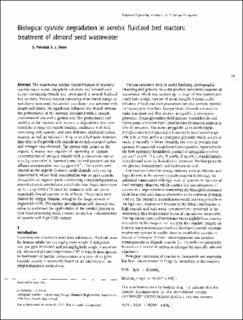Please use this identifier to cite or link to this item:
https://doi.org/10.21256/zhaw-4204Full metadata record
| DC Field | Value | Language |
|---|---|---|
| dc.contributor.author | Petrozzi, Sergio | - |
| dc.contributor.author | Dunn, Irving J. | - |
| dc.date.accessioned | 2018-02-27T14:50:44Z | - |
| dc.date.available | 2018-02-27T14:50:44Z | - |
| dc.date.issued | 1994 | - |
| dc.identifier.issn | 1615-7591 | de_CH |
| dc.identifier.issn | 1615-7605 | de_CH |
| dc.identifier.uri | https://digitalcollection.zhaw.ch/handle/11475/3247 | - |
| dc.description | Erworben im Rahmen der Schweizer Nationallizenzen (http://www.nationallizenzen.ch) | de_CH |
| dc.description.abstract | The continuous aerobic transformation of synthetic cyanide waste-water, amygdalin solutions and almond seed extract containing cyanide was investigated in several fluidized bed reactors. Various inocula consisting of activated sludge or soil slurry were used. Successful inoculation was achieved with simple soil slurry. No significant influence was found between the performance of the systems inoculated with a cyanide contaminated soil and a garden soil. The performance and stability of the reactors with respect to degradation rate were tested for a range of cyanide loading conditions, with feed containing only cyanide, and with different additional carbon sources, as well as various C∶N ratios at a hydraulic retention time of 24 h. No growth with cyanide as the sole source of carbon and nitrogen was observed. The system with lactate as the organic C-source was capable of operating at cyanide concentrations of 160 ppm cyanide with a conversion rate of 0.125 kg cyanide/m3 d. Ammonia was the end product and the effluent concentration was 0.5 ppm CN-. The systems with ethanol as the organic C-source could degrade only 0.05 kg cyanide/m3 d, whose feed concentration was 60 ppm cyanide. Amygdalin, an organic cyanide-containing compound present in stone fruit seeds, was fed as a model substrate. Degradation rates up to 1.2 kg COD/m3 d could be measured with no free or organically bound cyanide in the effluent. These rates were limited by oxygen transfer, owing to the large amount of degradable COD. The further investigations with almond seed extracts, confirmed the applicability of the aerobic process to treat food-processing waste streams having low concentrations of cyanide with high COD content. | de_CH |
| dc.language.iso | en | de_CH |
| dc.publisher | Springer | de_CH |
| dc.relation.ispartof | Bioprocess and Biosystems Engineering | de_CH |
| dc.rights | Licence according to publishing contract | de_CH |
| dc.subject | Cyanide | de_CH |
| dc.subject | Activate sludge | de_CH |
| dc.subject | Hydraulic retention time | de_CH |
| dc.subject | Amygdalin | de_CH |
| dc.subject | Soil slurry | de_CH |
| dc.subject.ddc | 572: Biochemie | de_CH |
| dc.title | Biological cyanide degradation in aerobic fluidized bed reactors : treatment of almond seed wastewater | de_CH |
| dc.type | Beitrag in wissenschaftlicher Zeitschrift | de_CH |
| dcterms.type | Text | de_CH |
| zhaw.departement | Life Sciences und Facility Management | de_CH |
| dc.identifier.doi | 10.21256/zhaw-4204 | - |
| dc.identifier.doi | 10.1007/BF00369612 | de_CH |
| zhaw.funding.eu | No | de_CH |
| zhaw.issue | 1 | de_CH |
| zhaw.originated.zhaw | No | de_CH |
| zhaw.pages.end | 38 | de_CH |
| zhaw.pages.start | 29 | de_CH |
| zhaw.publication.status | publishedVersion | de_CH |
| zhaw.volume | 11 | de_CH |
| zhaw.publication.review | Peer review (Publikation) | de_CH |
| Appears in collections: | Publikationen Life Sciences und Facility Management | |
Files in This Item:
| File | Description | Size | Format | |
|---|---|---|---|---|
| 1994_Petrozzi_Biological cyanide degradation_Bioprocess and Biosystems Engineering.pdf | 819.1 kB | Adobe PDF |  View/Open |
Show simple item record
Petrozzi, S., & Dunn, I. J. (1994). Biological cyanide degradation in aerobic fluidized bed reactors : treatment of almond seed wastewater. Bioprocess and Biosystems Engineering, 11(1), 29–38. https://doi.org/10.21256/zhaw-4204
Petrozzi, S. and Dunn, I.J. (1994) ‘Biological cyanide degradation in aerobic fluidized bed reactors : treatment of almond seed wastewater’, Bioprocess and Biosystems Engineering, 11(1), pp. 29–38. Available at: https://doi.org/10.21256/zhaw-4204.
S. Petrozzi and I. J. Dunn, “Biological cyanide degradation in aerobic fluidized bed reactors : treatment of almond seed wastewater,” Bioprocess and Biosystems Engineering, vol. 11, no. 1, pp. 29–38, 1994, doi: 10.21256/zhaw-4204.
PETROZZI, Sergio und Irving J. DUNN, 1994. Biological cyanide degradation in aerobic fluidized bed reactors : treatment of almond seed wastewater. Bioprocess and Biosystems Engineering. 1994. Bd. 11, Nr. 1, S. 29–38. DOI 10.21256/zhaw-4204
Petrozzi, Sergio, and Irving J. Dunn. 1994. “Biological Cyanide Degradation in Aerobic Fluidized Bed Reactors : Treatment of Almond Seed Wastewater.” Bioprocess and Biosystems Engineering 11 (1): 29–38. https://doi.org/10.21256/zhaw-4204.
Petrozzi, Sergio, and Irving J. Dunn. “Biological Cyanide Degradation in Aerobic Fluidized Bed Reactors : Treatment of Almond Seed Wastewater.” Bioprocess and Biosystems Engineering, vol. 11, no. 1, 1994, pp. 29–38, https://doi.org/10.21256/zhaw-4204.
Items in DSpace are protected by copyright, with all rights reserved, unless otherwise indicated.